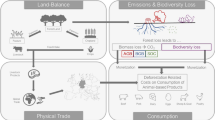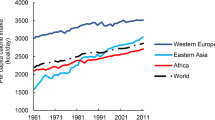Abstract
Urban consumption of ecosystems services such as food generates environmental impacts at different geographical scales. In the last few decades Tokyoites have shown an increasing appetite for meat. This study examines the environmental implications of Tokyo’s increasing meat consumption by analyzing how this trend has affected land use and cover change in areas near and far away. Historical databases (1970–2005) are employed in order to explore meat consumption patterns in Tokyo and to relate it with beef and pork production in areas within the country and abroad. It also integrates the historical analysis of production and consumption patterns with a discussion of the drivers (e.g., wealth, price, policies and seafood availability) behind these trends. We identified that meat production in Japan followed three distinct phases between 1877 and 2005. In the first period it took 50 years for production to increase by 50%, while during the next phase production showed the same growth in just half the time. Major changes in land use/cover change because of domestic meat production occurred mainly during the second phase and, thereafter, when domestic production declined and was substituted to a great extent by imports. Despite the increasing consumption of imported meat, Tokyo relies greatly on domestic meat produced in its neighboring prefectures. The paper concludes that regional planning can be used as an effective instrument to protect the environment and secure protein for the population of mega-urban areas such as Tokyo.












Similar content being viewed by others
Notes
By meat we mean terrestrial animal carcasses used as food.
By Tokyo we mean Tokyo’s 23 wards.
South Kanto includes Saitama, Chiba, Tokyo and Kanagawa. Other Kanto includes Ibaraki, Tochigi and Gunma.
References
Belsky AJ, Matzke A, Uselman S (1999) Survey of livestock influences on stream and riparian ecosystems in the western United States. J Soil Water Conserv 54:419–431
Bestor T (2004) Tsukiji: the Fish market at the center of the world. University of California Press, Berkeley and Los Angeles
Clay JW (2004) World agriculture and the environment: a commodity-by-commodity guide to impacts and practices. Island Press, Washington, DC
FAO (2008) Food balance sheets. Food and Agricultural Organization, Rome. http://faostat.fao.org/site/502/default.aspx. Accessed July 2008
Galloway JN, Burke M, Bradford GE, Naylor R, Falcon W, Chapagain A, Gaskell J, McCullough E, Mooney HA, Oleson KLL, Steinfeld H, Wassenaar T, Smil V (2007) International trade in meat: the tip of the pork chop. Ambio 36:622–629
Hayami Y (1979) Trade benefits to all: a design of the beef import liberalization in Japan. Am J Agric Econom 61:342–347
MAFF (1971a) Statistics by farm enterprise in animal industry (Keiei Bumonbetsu Noka Tokei Hokokusho). Ministry for Agriculture, Forestry and Fisheries, Tokyo (in Japanese)
MAFF (1971b) Statistics by type of farm (Noka Chosa Hokokusho). Ministry for Agriculture, Forestry and Fisheries, Tokyo (in Japanese)
MAFF (1971c) Edible meat circulation statistics (Shokuniku ryutu Toke). Ministry for Agriculture, Forestry and Fisheries, Tokyo (in Japanese)
MAFF (1976a) Statistics by farm enterprise in animal industry (Keiei Bumonbetsu Noka Tokei Hokokusho). Ministry for Agriculture, Forestry and Fisheries, Tokyo (in Japanese)
MAFF (1976b) Statistics by type of farm (Noka Chosa Hokokusho). Ministry for Agriculture, Forestry and Fisheries, Tokyo (in Japanese)
MAFF (1976c) Edible meat circulation statistics (Shokuniku ryutu Toke). Ministry for Agriculture, Forestry and Fisheries, Tokyo (in Japanese)
MAFF (1981a) Statistics by farm enterprise in animal industry (Keiei Bumonbetsu Noka Tokei Hokokusho). Ministry for Agriculture, Forestry and Fisheries, Tokyo (in Japanese)
MAFF (1981b) Statistics by type of farm (Noka Chosa Hokokusho). Ministry for Agriculture, Forestry and Fisheries, Tokyo (in Japanese)
MAFF (1981c) Edible meat circulation statistics (Shokuniku ryutu Toke). Ministry for Agriculture, Forestry and Fisheries, Tokyo (in Japanese)
MAFF (1986a) Statistics by farm enterprise in animal industry (Keiei Bumonbetsu Noka Tokei Hokokusho). Ministry for Agriculture, Forestry and Fisheries, Tokyo (in Japanese)
MAFF (1986b) Statistics by type of farm (Noka Chosa Hokokusho). Ministry for Agriculture, Forestry and Fisheries, Tokyo (in Japanese)
MAFF (1986c) Edible meat circulation statistics (Shokuniku ryutu Toke). Ministry for Agriculture, Forestry and Fisheries, Tokyo (in Japanese)
MAFF (1991a) Statistics by farm enterprise in animal industry (Keiei Bumonbetsu Noka Tokei Hokokusho). Ministry for Agriculture, Forestry and Fisheries, Tokyo (in Japanese)
MAFF (1991b) Statistics by type of farm (Noka Chosa Hokokusho). Ministry for Agriculture, Forestry and Fisheries, Tokyo (in Japanese)
MAFF (1991c) Edible meat circulation statistics (Chikusan Ryutu Tokei). Ministry for Agriculture, Forestry and Fisheries, Tokyo (in Japanese)
MAFF (1996a) Statistics by farm enterprise in animal industry (Keiei Bumonbetsu Noka Tokei Hokokusho). Ministry for Agriculture, Forestry and Fisheries, Tokyo (in Japanese)
MAFF (1996b) Statistics by type of farm (Noka Chosa Hokokusho). Ministry for Agriculture, Forestry and Fisheries, Tokyo (in Japanese)
MAFF (1996c) Edible meat circulation statistics (Chikusan Ryutu Tokei). Ministry for Agriculture, Forestry and Fisheries, Tokyo (in Japanese)
MAFF (2001a) Statistics by farm enterprise in animal industry (Keiei Bumonbetsu Noka Tokei Hokokusho). Ministry for Agriculture, Forestry and Fisheries, Tokyo (in Japanese)
MAFF (2001b) Statistics by type of farm (Noka Chosa Hokokusho). Ministry for Agriculture, Forestry and Fisheries, Tokyo (in Japanese)
MAFF (2001c) Edible meat circulation statistics (Chikusan Ryutu Tokei). Ministry for Agriculture, Forestry and Fisheries, Tokyo (in Japanese)
MAFF (2006a) Statistics by farm enterprise in animal industry (Keiei Bumonbetsu Noka Tokei Hokokusho). Ministry for Agriculture, Forestry and Fisheries, Tokyo (in Japanese)
MAFF (2006b) Statistics by type of farm (Noka Chosa Hokokusho). Ministry for Agriculture, Forestry and Fisheries, Tokyo (in Japanese)
MAFF (2006c) Edible meat circulation statistics (Chikusan Ryutu Tokei). Ministry for Agriculture, Forestry and Fisheries, Tokyo (in Japanese)
MAFF (2006d) Annual Report on Food, Agriculture and Rural Areas in Japan. Ministry of Agriculture, Forestry and Fisheries, Tokyo. http://www.maff.go.jp/e/annual_report/pdf/fy2006_rep.pdf. Accessed July 2008
MAFF (2007) Edible meat circulation statistics (Chikusan Ryutu Tokei). Ministry for Agriculture, Forestry and Fisheries, Tokyo (in Japanese)
MIAC (2008a) Area by Land Category (1963–1998). Ministry of Internal Affairs and Communication, Tokyo. http://www.stat.go.jp/data/chouki/zuhyou/01-08.xls. Accessed July 2008
MIAC (2008b) Area by Land Category (1995–2004). Ministry of Internal Affairs and Communication, Tokyo. http://www.stat.go.jp/data/nenkan/zuhyou/y0106000.xls. Accessed July 2008
MIAC (2008c) Intake of Nutrients—Per Capita per Diem (F.Y.1946–1963, C.Y.1964–2004). Ministry of Internal Affairs and Communication, Tokyo. http://www.stat.go.jp/data/chouki/zuhyou/24-01.xls. Accessed July 2008
MIAC (2008d) Farm Households Raising Livestock or Chickens and Livestock or Chickens Raised (1877–2005). Ministry of Internal Affairs and Communication, Tokyo. http://www.stat.go.jp/data/chouki/zuhyou/07-17.xls. Accessed July 2008
MIAC (2008e) Production of raw milk, hen’s eggs, chicken and carcass (1894–2003). Ministry of Internal Affairs and Communication, Tokyo. http://www.stat.go.jp/data/chouki/zuhyou/07-18.xls. Accessed July 2008
MIAC (2008f) Population of cities (1920–2005). Ministry of Internal Affairs and Communication, Tokyo. http://www.stat.go.jp/data/chouki/zuhyou/02-09.xls. Accessed July 2008
MIAC (2008g) Population, daytime population and ratio of daytime population to nighttime population of major cities (1965–2000). Ministry of Internal Affairs and Communication, Tokyo. http://www.stat.go.jp/data/chouki/zuhyou/02-08.xls. Accessed July 2008
MIAC (2008h) Average monthly earnings of regular employees by prefectures. Ministry of Internal Affairs and Communication, Tokyo. http://www.stat.go.jp/data/chouki/zuhyou/19-41.xls. Accessed July 2008
MIAC (2008i) Prefectural accounts—68SNA (F.Y.1975–1999). Ministry of Internal Affairs and Communication, Tokyo. http://www.stat.go.jp/data/chouki/zuhyou/03-37-a.xls. Accessed July 2008
MIAC (2008j) Economic growth rate and prefectural income per capita (F.Y. 2000–2004). Ministry of Internal Affairs and Communication, Tokyo. http://www.stat.go.jp/data/nenkan/zuhyou/y0314a00.xls. Accessed July 2008
MIAC (2008k) Self-sufficiency ratio of food (F.Y.1960–2003). Ministry of Internal Affairs and Communication, Tokyo. http://www.stat.go.jp/data/chouki/zuhyou/07-56.xls. Accessed July 2008
Naylor R, Steinfeld H, Falcon W, Galloway J, Smil V, Bradford E, Alder J, Mooney H (2005) Losing the links between livestock and land. Science 310:1621–1622
Otsuka S (1996) Japanese food, fast and present. About Japan series. Tokyo Foreign Press Center, Tokyo
Sakurai A (2004) Stories of the Slaughterhouse. The journal of humanities 33: LXXI-XCIV. Chiba University. http://ci.nii.ac.jp/cinii/servlet/QuotDisp?LOCALID=ART0007286046&DB=NELS&USELANG=en. Accessed 21 July 2008
Stanford C, Bunn HT (eds) (2001) Meat-eating and human evolution. Oxford University Press, Oxford
Steinfeld H, Gerber P, Wassenaar T, Castel V, Rosales M, de Haan C (2006) Livestock’s long shadow: environmental issues and options. Food and Agriculture Organization (FAO), Rome
TMG (1971) Tokyo wholesale market annual report (Tokyo-to Chio Oroshiuri Shijo Nenpo). Tokyo Metropolitan Government, Tokyo (in Japanese)
TMG (1976) Tokyo wholesale market annual report (Tokyo-to Chio Oroshiuri Shijo Nenpo). Tokyo Metropolitan Government, Tokyo (in Japanese)
TMG (1981) Tokyo wholesale market annual report (Tokyo-to Chio Oroshiuri Shijo Nenpo). Tokyo Metropolitan Government, Tokyo (in Japanese)
TMG (1986) Tokyo wholesale market annual report (Tokyo-to Chio Oroshiuri Shijo Nenpo). Tokyo Metropolitan Government, Tokyo (in Japanese)
TMG (1991) Tokyo wholesale market annual report (Tokyo-to Chio Oroshiuri Shijo Nenpo). Tokyo Metropolitan Government, Tokyo (in Japanese)
TMG (1996) Tokyo wholesale market annual report (Tokyo-to Chio Oroshiuri Shijo Nenpo). Tokyo Metropolitan Government, Tokyo (in Japanese)
TMG (2001) Tokyo wholesale market annual report (Tokyo-to Chio Oroshiuri Shijo Nenpo). Tokyo Metropolitan Government, Tokyo (in Japanese)
TMG (2006a) Tokyo wholesale market annual report (Tokyo-to Chio Oroshiuri Shijo Nenpo). Tokyo Metropolitan Government, Tokyo (in Japanese)
TMG (2006b) Destination of landings in Tokyo wholesale market. Tokyo Metropolitan Government, Tokyo (in Japanese)
TMG (2007) Nutritional status of Tokyo`s residents. Tokyo Metropolitan Government, Tokyo (in Japanese)
Wassenaar T, Gerber P, Verburg PH, Rosales M, Ibrahim M, Steinfeld H (2007) Projecting land use changes in the Neotropics. The geography of pasture expansion into forest. Glob Environ Change 17:86–104
Zhang YK, Schilling KE (2006) Increasing streamflow and baseflow in Mississippi River since the 1940s: effect of land use change. J Hydrol 324:412–422
Acknowledgments
Alexandros Gasparatos would like to acknowledge the support of the Canon Foundation for Europe. We also acknowledge the generous help from Mr. Ryutaro Arai (TMG) and Mr. Kimihiro Eura (MAFF) in clarifying our doubts and providing us further information about the TMG and MAFF datasets.
Author information
Authors and Affiliations
Corresponding author
Electronic supplementary material
Below is the link to the electronic supplementary material.
Rights and permissions
About this article
Cite this article
Gadda, T., Gasparatos, A. Land use and cover change in Japan and Tokyo’s appetite for meat. Sustain Sci 4, 165–177 (2009). https://doi.org/10.1007/s11625-009-0085-1
Received:
Accepted:
Published:
Issue Date:
DOI: https://doi.org/10.1007/s11625-009-0085-1




